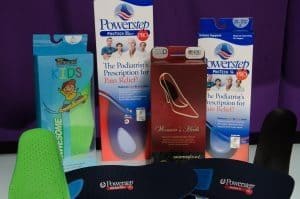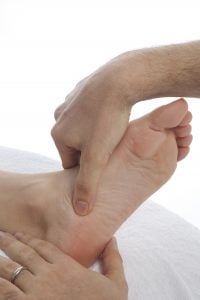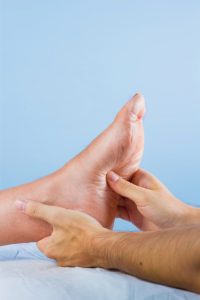Plantar Fasciitis

PLANTAR FASCIITIS (HEEL PAIN)
Heel pain you feel on the underside or bottom of the foot often causes an often-painful condition called Plantar Fasciitis.
- Plantar Fasciitis, also called a heel spur, causes pain, irritation, and inflammation across the bottom of the foot. The plantar fascia, is a ligament that runs from the heel of your foot to the ball. It connects your heel bone to your toes. When this ligament becomes strained, it can result in chronic pain.
What Does Plantar Fasciitis Feel Like?
- It’s one of the most common causes of foot discomfort. Plantar fasciitis causes a sharp pain. This feels like a pin or knife stuck in your heel when you wake up in the morning and begin walking. Although the pain will start to subside as you move around through the day, it can reappear if you stand for a long period of time. Above all, the worst pain comes when you stand up after sitting behind a desk for most of the day.
Who Is Most Susceptible to Plantar Fasciitis?
- Runners and other athletes
- Pregnant women
- Those who are overweight and often stand and walk
- People who wear shoes that have little to no support
- Adults who are getting older
Is stretching effective in managing plantar fasciitis?
Yes, stretching can be effective in managing plantar fasciitis. Stretching exercises that target the calf muscles and the Achilles tendon can help alleviate the tension on the plantar fascia, which is a thick band of tissue on the bottom of the foot. These stretches are often recommended as part of a comprehensive treatment plan. Common stretches include calf stretches against a wall, rolling a tennis ball under the foot, and using a towel to stretch the foot. Regular stretching can increase flexibility, reduce pain, and promote healing. However, it’s important to perform these stretches correctly and consistently, under the guidance of a healthcare professional, to ensure their effectiveness.
How long does it typically take to recover from plantar fasciitis?
The recovery time for plantar fasciitis varies widely among individuals. Mild cases may resolve within a few weeks with conservative treatments like rest, stretching, and orthotics. However, more severe or chronic cases can take several months to a year or more to fully recover. Factors affecting recovery time include the individual’s age, overall health, adherence to treatment, and the severity of the condition. It’s crucial to follow a tailored treatment plan, which may include rest, physical therapy, orthotic devices, and, in some cases, corticosteroid injections or surgery. Early intervention and patience are key to achieving a full recovery and preventing recurrence.
Can plantar fasciitis lead to other foot or leg problems?
Yes, if left untreated, plantar fasciitis can potentially lead to other foot or leg problems. Over time, the altered gait and posture caused by the pain and discomfort of plantar fasciitis can result in issues like knee, hip, or lower back pain. Additionally, compensatory movements to avoid pain may put excess stress on other areas of the foot and leg, potentially leading to secondary problems such as Achilles tendonitis or shin splints.
What are plantar fasciitis treatments in Pittsburgh?

There are many treatments available for plantar fasciitis in Pittsburgh.
- Home Physical Therapy. Do this before you even take your first steps out of bed in the morning. Grab a band or a towel and wrap it around the ball of the foot and pull backward toward your nose. Do this several times on whichever arch has pain.
- Ice it down.- Forget the frozen water bottles, simply get an ice pack, or bag of frozen veggies.Place your heel on it after work every evening. Do this for about 10-15 minutes.
- Custom Orthotics. You need to take the weight of your body off your arch. You can accomplish this with firm orthotics, with or without a soft topcover.
- NSAIDs- Nonsteroidal anti-inflammatory drugs like alleve, naproxen, or ibuprofen can help. Use under your podiatrists’ direction.
- Injections of cortisone. – A powerful anti-inflammatory, cortisone is a medication we administer via a quick injection into the plantar fascia. You use it to reduce pain and inflammation.
- ESWT Extracorporeal Shockwave Therapy -ESWT – a nonsurgical , noninvasice office procedure. It delivers high-energy acoustic (sound) waves into the area of maximum pain. Used for the heel, arch, or Achilles tendon. This is a 20 minute one time procedure. Requires no time off of work and saves many sufferers from unnecessary surgery!
- Think you have plantar fasciitis in Pittsburgh? Call 878-313-3338 for help locating our nearest office to you.

Powerstep® Sports Supports
Explore Foot Braces, Night Splints for Feet, and More
Orthotic insoles aren’t your only option to relieve your foot pain. Sports orthotics like night splints for feet and jumpers knee straps are also great resources. We design them to help you overcome painful injuries or foot conditions. The Powersteps® we provide offer a variety of sports orthotic products. They can alleviate common foot conditions. We offer night socks or night splints that act as great nighttime options for alleviating symptoms of Plantar Fasciitis. You can also explore our line of foot rockers, Achilles tendon straps, IT knee bands, and much more to relieve pain from stress fractures and other common foot conditions.
We’re ready to help.
Schedule an appointment with Beaver Valley Foot Clinic today.
What Is Plantar Fasciitis?
What Are The Benefits of ESWT?
- It works! It’s a proven pain relief procedure for the discomfort chronic Plantar Fasciitis and heel spurs causes. The shock waves used in ESWT actually stimulate the body’s own repair mechanisms.
- It’s less than a 30-minute in-office procedure and has a short recovery period. There’s no need to take a day off of work—you can have this procedure done during your lunch hour. You can also walk as soon as you finish the ESWT and you should be able to restart your regular activity the next day.
- Requires no surgery. ESWT is gentle and uses shock waves. Therefore, we make no incisions. As a result his removes the risks we associate with surgery.
- No pain medication is necessary, and there are no side effects. We lightly numbed heel and gel before the procedure.
What happens during the ESWT treatment?
First, we confirm your pain with an ultrasound. We then lightly numb the affected area on your foot and you’ll lie down or sit on an exam table. After we apply a gel to the foot, the ESWT device releases shock waves as we properly position your foot. The whole office visit takes only 30 minutes.
If you are suffering from Plantar Fasciitis, call Beaver Valley Foot Clinic today to learn more about the benefits of Extracorporeal Shockwave Therapy.
PATIENT TESTIMONIALS ESWT
Read what patients are saying about Extracorporeal Shock Wave Therapy…
“I’ve had foot pain for over twenty years, no wonder, my job requires being on my feet eight to twelve hours a day, six days a week. I thought I would always have pain. Then I tried ESWT. Thankfully, I was wrong.
“Working 12 hours a day in the steel mill guarantees you one thing, unbearable foot pain. The worse it got, the less I could work, until ESWT. It has truly changed my life. In just two weeks I was pain free. It doesn’t get any better than that, unless we win the Super Bowl of course.
““I have traveled every road to try and find relief for my heel spurs-shots, taping, medicine, show inserts, losing weight and wore tennis shoes. Results-no result, until ESWT. If you don’t believe me just ask my feet.”
Questions for Dr Teimouri DPM about Heel Pain, email her here!
PODIATRY CLINIC HOURS
Mon to Fri: 8:00 am to 5:30 pm
Emergency evening and weekend appointments
Call for information on Plantar Fasciitis or schedule an appt 878-313-FEET (3338)
Frequently Asked Questions about cause and treatments for PLANTAR FASCIITIS
What is Shock Wave Therapy –
ESWT, and Extra-corporeal Shock Wave Therapy?
- Shock wave therapy is not new. It has been around since the 60’s as lithotripsy in the treatment of kidney stones. It a 20 minute non-invasive treatment for plantar fasciitis and other chronic musculotendinous injuries. Extracorporeal Shockwave Therapy delivers small bursts of high intensity sound waves into chronically damaged fascia in the heel and arch. It is these areas which cause the painful arch symptoms in most patients. This allows these tendons to heal the right way and symptoms to improve. We typically recommend that our Plantar fasciitis Mt Lebanon patients ask about ESWT after exhausting conservative treatments and before surgery.
How does ESWT Pittsburgh work for Plantar Fasciitis?
Image of ESWT Machine for Achilles Shockwave Therapy, Pittsburgh PA
- ESWT uses the most effective mechanisms to treating plantar fascia pain and more chronic injuries. In an over-use injury like plantar fasciitis, tendons and ligaments of the heel and arch where the plantar fascia connects to the calcaneous become inflamed damaged due to overuse. The arch never gets a chance to heal properly. Extracorporeal Shock Wave Therapy intentionally causes controlled amounts of damage. This is micro-trauma. It is created at the exact point on ultrasound guidance where the fascia inserts into the heel bone. One might think this is the opposite of what one wants to do—why would one want a treatment to create more damage? Actually shock wave therapy triggers the body’s own healing response. It jump starts the natural healing mechanisms. It also accomplishes two other specific goals. The first one -breaks down scar tissue that has formed. It causes fresh collagen production. Collagen makes up tendons and ligaments. In an over-use injury, this gradually breaks down the collagen. The micro-trauma caused by Shock wave actually stimulates collagen production. This is part of the triggered healing process. Secondly, it increase the flow of blood to the area. ESWT treatments increase blood flow to the injured area. An injured area requires this to heal correctly. Note that fascial tissue usually has very poor blood flow. That makes healing much more difficult. ESWT directly promotes increased blood supply. We recommend ESWT for chronic plantar fascia pain patients.
Frequently Asked Questions
What’s Shock Wave Therapy treatment Pittsburgh PA like?
- First we perform a thorough exam, along with a detailed H&P. The podiatrist will discuss treatment options with you. We will decide together if ESWT is the most appropriate treatment. Once we medically clear you for Extracorporeal Shock Wave Therapy, the Your Podiatrist cleans the heel and administers a regional lidocaine. Patients generally tolerate Shockwave very well. However, if you don't need numbed, then in most cases you are receiving a low intensity instead of high intensity treatment. Those are not FDA approved. Like lithotripsy for kidney stones, the We place the foot on a “water bladder” which is a part of the ESWT generator. The high intensity pressure wave energy travels best through water. We administer 3800 pulses of high intensity waves of energy to the plantar fascia, heel and arch. The patient hears a clicking sound as we generate the pressure waves. The patient usually feels little to no pain. The treatment is 18 minutes long once it has started.
Does Cranberry ESWT work? How successful is Shock Wave Therapy for Plantar Fasciitis?
- Shockwave therapy works! It has an excellent success rates for chronic plantar fasciitis treatment especially compared to painful and often unnecessary surgery! Several research papers have estimated ESWT’s success rates at 80% or higher. In these research papers, success was defined as a “good” or “excellent” outcome according to the patient, which means that the patient has normal function with or without minor pain, or normal function with no pain at all. Dr. Teimouri DPM in our Bridgewater Foot Clinic has been in practice for 23+ years and has seen many satisfied patients since 2002.
Is ESWT Beaver painful? Does it hurt?
- No, ESWT is not painful. Patients can feel either minor disco
 mfort or nothing at all after we lightly numb them. Our patients with plantar fasciitis in Moon Township are usually surprised at how comfortable the ESWT treatment really is. Some patients have even fallen asleep!
mfort or nothing at all after we lightly numb them. Our patients with plantar fasciitis in Moon Township are usually surprised at how comfortable the ESWT treatment really is. Some patients have even fallen asleep!
Who is the ideal New York ESWT candidate?
- An ideal candidate is any one who has tried and failed 3 conservative treatments. These include stretching, icing, and arch supports. If you have not found relief, you are a good candidate for Shock Wave Therapy. Any one thinking about a surgical approach should definitely consider minimally invasive or non-invasive procedures like Shock Wave Therapy first. We strongly recommend ESWT to many of our plantar fasciitis Beaver patients.
Who should not get ESWT New York?
Some patients don’t qualify for an ESWT. However, it has been used successfully on all major patient populations.
- Don't use it over or near a bone growth center until bone growth is complete.
- If you have a calcaneal stress fracture, don't have a shock wave.
- Don't have an ESWT when you know you have a malignant disease present in or near the treatment area.
- Infection in the area to be treated is contraindicated.
- Patients who have a coagulation disorder or taking anti-coagulant medications should not have ESWT.
- When a patient has a prosthetic device in the area to be treated, consider other options.
I’ve had cortisone injections but they did not work. Is ESWT New Jersey right for me?
- ESWT is a great option for non-healing plantar fascia New Jersey patients who have not achieved full relief with shots. In fact, Shock wave treatment has reduced the need for more injections in most patients. Every one is different. Ultimately, while there are no absolute rules, make sure to discuss it with your podiatrist.
Are patients satisfied with ESWT in Philladelphia?
- Yes. ESWT satisfies many of our patients with plantar fasciitis in Wexford. Patients have highly recommended it to their friends and families!
Is ESWT NYC a type of surgery, and is ESWT invasive?
- Extracorporeal Shock Wave Therapy New Jersey does not cut the skin at all. We do not consider it surgery. ESWT is a non-invasive treatment. Ultimately, this is a major reason doctors regard it as a better option than surgery.
Is Extracorporeal Shock Wave Therapy a good option for patients who have failed open surgery for plantar fasciitis?
- Yes, ESWT is a good option for those who have failed traditional plantar fascia surgery. Many people with failed surgery get excellent results with ESWT.
Orthotripsy, ESWT machine for Achilles Tendinitis, Pittsburgh PA
What are the most common side-effects of ESWT , Philadelphia? What are potential ESWT complications?
- ESWT Philadelphia is not an invasive procedure. Therefore, many may only have a little numbness or soreness for several days after the procedure. Usually there are no other ill effects. Our Plantar Fasciitis Beaver patients frequently report this as the extent of their common side-effects.
How does one prepare for a Extracorporeal Shock Wave Treatment?
- There is not any special prep needed before Extracorporeal Shock Wave Therapy New Jersey.
Are there medicines should I quit taking before ESWT treatment?
- Before ESWT patients should discontinue NSAIDS, Coumadin, and other blood thinners . These would increase bruising to the area.
What should I do after my Extracorporeal Shock Wave Therapy procedure?
Wh at’s the ESWT after-care?
at’s the ESWT after-care?
- No special post procedural care is necessary. A patients can use heat but not ice if wanted after treatment. Tylenol is OK for pain.
When can I expect to see the maximum results of the procedure?
- Patients usually feel significant relief by month three. Although, after the first two weeks or so, it often improves little by little as the area heals itself naturally. Symptoms lessen gradually in the following weeks after the ESWT. It then usually disappears completely.
When can patients resume normal, everyday activities after a Shock Wave Therapy like house work, driving, running and walking?
- You can resume normal daily activities immediately. However, running, tennis and high impact activities should be delayed for several weeks.
How soon can I go back to higher impact, vigorous activities like sports and weight lifting?
- We tell our patients with plantar fasciitis McCandless to wait fourteen days to resume vigorous activity. This allows for an optimal outcome.
What’s the best outcome I can expect after Extracorporeal Shockwave?
- After ESWT one can expect complete relief of the symptoms of plantar fasciitis. After 2 weeks resume normal activities with no restrictions.
What’s the worst outcome I can expect from ESWT?
- There is not any procedure guaranteed to succeed 100% of the time. For example, a patient with several failed surgeries with extensive fascia, tendon, and ligamentous damage may experience no relief at all. This being said, ESWT has not been shown to make plantar fasciitis or other conditions worse.
Is ESWT covered by insurance? What are the costs of the procedure?
- Many of our Plantar Fascia, Mars patients have had insurance cover this procedure, the office manager will check insurance eligibility for each person or you can call and check your benefits.
Is ESWT FDA approved?
- Dornier Epos Ultra by- Dornier Medical Systems, Inc.; FDA inspection of the facility determined that the applicant was in compliance with the Quality System Regulation (21 CFR 820). Approval for this PMA application was issued on January 15, 2002.
- The National Institute for Clinical Excellence (NICE) reviewed the procedure in 2015 and approved Shockwave therapy for general use in all medical facilities.
- Indications for Use The Dornier Epos Ultra: It is a non-surgical option for the treatment of chronic plantar fasciitis. It is used for patients with symptoms of plantar fasciitis lasting 6 months or more. Patients must have a history of failed conservative therapy. Plantar fasciitis is defined as the traction degeneration of the plantar fascial band at its origin on the medial tubercle of the calcaneus.
What else is Shockwave Therapy Philladelphia used for?
- Extracorporeal Shock Wave Therapy was originally developed in the 1960’s as lithotripsy, to break up kidney stones, and was soon adapted to treat other conditions. Now ESWT is often used to treat tennis elbow, achilles tendonitis, plantar fasciitis and other soft-tissue injuries. Theoretically, Shock Wave Therapy can be used to provide an effective treatment for many over-use injuries involving fascia, tendons and ligaments.
Plantar fasciitis studies:
Plantar fasciitis Study #1
Ching-Jen Wang, MD, and his colleagues found 82.7% go
od-to-excellent results and a 12% recurrence rate in plantar fasciitis patients at a
Plantar fasciitis Study #2 (Click to see full study)
“The results of this study confirm that ESWT administered with the Dornier Epos Ultra is a safe and effective treatment for recalcitrant plantar fasciitis.”
Plantar fasciitis Study #3 (Click to see full study)
It was concluded that ESWT was both efficacious and safe for
Plantar fasciitis Studies (Click to see full studies on pages 17 & 18)
https://www.ismst.com/pdf/abstracts12congress.pdf
Study #15 entitled: “Effectiveness of Shockwave Therapy in Patients with Chronic Plantar Fasciitis” found on page 17
#16 Study entitled: “Plantar Fasciitis: Four Years After ESWT” found on page 18
Study #17 entitled: “ESWT in the Treatment of Plantar Fasciitis: follow-up at three years” found on page 18


